- Home
- Oliver Sacks
Seeing Voices Page 14
Seeing Voices Read online
Page 14
18. In When the Mind Hears, Harlan Lane becomes a novelist-biographer-historian and assumes the persona of Clerc, through whom he recounts the early history of the deaf. Since Clerc’s rich and long life spanned the most crucial developments, in many of which, indeed, he played a leading part, his “autobiography” becomes a wonderfully personal history of the deaf.
The story of Laurent Clerc’s enlistment and coming to America is a cherished piece of deaf history and folklore. As the Reverend Thomas Gallaudet (so the story goes) was watching some children playing in his garden one day, he was struck by the fact that one of them did not join in the fun. He found out that her name was Alice Cogswell—and that she was deaf. He tried to teach her himself and then spoke to her father, Mason Cogswell, a surgeon in Hartford, about setting up a school for the deaf there (there were no schools for the deaf in the United States at this time).
Gallaudet sailed for Europe, looking for a teacher, someone who could found, or help found, a school in Hartford. He went first to England, to one of the Braidwood schools, one of the “oral” schools that had been set up in the previous century (it was a Braidwood school that Samuel Johnson had seen, on his journey to the Hebrides), but was given a cold welcome there: the oral method, he was told, was a “secret.” After this experience in England, he went on to Paris, and there found Laurent Clerc teaching in the Institute of Deaf-Mutes. Would he—himself a deaf-mute, who had never ventured from his native France; nor indeed, much beyond the confines of the Institute—would he be willing to come and bring the Word (the Sign) to America? Clerc agreed, and the two of them set sail; and on the fifty-two-day journey to the United States, he taught Gallaudet Sign, and Gallaudet taught him English. Soon after their arrival, they started raising funds—both public and legislature were excited and generous—and the next year, with Mason Cogswell, they opened the Asylum in Hartford. A statue of Thomas Gallaudet, giving a lesson to Alice, stands on the grounds of Gallaudet University today.
19. This atmosphere breathes from every page of a delightful book, The Deaf and the Dumb by Edwin John Mann, Late Pupil of the Hartford Asylum, published by Hitchcock in 1836.
20. We lack sufficient direct knowledge of the evolution of ASL, especially in its first fifty years, when a far-reaching “creolization” occurred, as French Sign Language became Americanized (see Fischer, 1978, and Woodward, 1978). There was already a wide gulf between French Sign and the new creole ASL by 1867—Clerc himself commented on this—and this has continued to grow in the past hundred and twenty years. Nonetheless, there are still significant similarities between the two languages—sufficient for an American signer to feel somewhat at home in Paris. In contrast, American signers have great difficulty understanding British Sign Language, which has quite different indigenous origins of its own.
21. Indigenous sign dialects may be extremely different: thus prior to 1817, a deaf American traveling across the States would encounter sign dialects incomprehensibly different from his own; and standardization was so slow in England that until quite recently signers in adjacent villages might be mutually unintelligible.
22. The old terms “deaf and dumb” and “deaf-mute” referred to a supposed inadequacy of those born deaf to speak. They are, of course, perfectly capable of speech—they have the same speech apparatus as anyone else; what they lack is the ability to hear their own speech, and thus to monitor its sound by ear. Their speech, therefore, may be abnormal in amplitude and tone, with many omitted consonants and other speech sounds, sometimes so much so as to be unintelligible. Since deaf people cannot monitor their speech by ear, they have to learn to monitor it by other senses—by vision, touch, vibration-sense, and kinesthesia. Moreover, the prelingually deaf have no auditory image, no idea what speech actually sounds like, no idea of a sound-meaning correspondence. What is essentially an auditory phenomenon must be grasped and controlled by nonauditory means. It is this which poses great difficulties, and which may require thousands of hours of individual tuition to achieve.
It is for this reason that the voices of the pre-and postlingually deaf are usually quite different, and distinguishable at once; the postlingually deaf remember how to speak, even though they can no longer readily monitor their speech; the prelingually deaf must be taught how to speak, without any sense or memory of how it sounds.
23. Although Bell has been seen as something of an ogre by the deaf (George Veditz, a former president of the National Association of the Deaf, and a hero of the deaf, called him “the most to be feared enemy of the American deaf”), it should be noted that Bell said on one occasion:
I think that if we have the mental condition of the child alone in view without reference to language, no language will reach the mind like the language of signs; it is the method of reaching the mind of the deaf child.
Nor was he himself ignorant of Sign; he was, on the contrary, “a fluent signer on his fingers—as good as any deaf-mute … [he] could use his fingers with bewitching grace and ease,” in the words of his deaf friend Albert Ballin. Ballin also called Bell’s interest in the deaf “a hobby”—but it bears many of the marks, rather, of a violent and conflicted obsession (see Gannon, 1981, pp. 78–79).
24. Many of the deaf are now functional illiterates. A study carried out by Gallaudet College in 1972 showed that the average reading level of eighteen-year-old deaf high school graduates in the United States was only at a fourth-grade level, and a study by the British psychologist R. Conrad indicates a similar situation in England, with deaf students, at graduation, reading at the level of nine-year-olds (Conrad, 1979).
25. There had, of course, been other novels, like Carson McCullers’s The Heart Is a Lonely Hunter. The figure of Mr. Singer, an isolated deaf man in a hearing world, in this book is quite different from the protagonists of Greenberg’s novel, who are vividly conscious of their deaf identities. A huge social change, a change in social outlook, has occurred in the intervening thirty years, with above all, the emergence of a new self-consciousness.
26. Though there may be early development of a vocabulary of signs, the development of Sign grammar takes place at the same age, and in the same way, as the acquisition of speech grammar. Linguistic development thus occurs at the same rate in all children, deaf or hearing. If signs appear earlier than speech, it is because they are easier to make, for they involve relatively simple and slow movements of muscles, whereas speech involves the lightning coordination of hundreds of different structures, and only becomes possible in the second year of life. Yet it is intriguing that a deaf child at four months may make the sign for “milk,” where a hearing child can only cry or look around. Perhaps all babies would be better off knowing a few signs!
27. One may suspect deafness from observation, but one cannot easily prove it in the first year of life. If, therefore, there is any reason to suspect deafness—for example, because there have been other deaf people in the family, or there is a lack of response to sudden noises—there should be physiological testing of the brain’s response to sound (measuring so-called auditory evoked potentials in the brainstem). This test, relatively simple, can confirm or rule out the diagnosis of deafness as early as the first week of life.
28. Sicard imagined such a community:
Could there not be in some corner of the world a whole society of deaf people? Well then! Would we think that these individuals were inferior, that they were unintelligent and lacked communication? They would certainly have a sign language, perhaps a language even richer than ours. This language would at least be unambiguous, always giving an accurate picture of the mind’s affections. So why would this people be uncivilized? Why wouldn’t they in fact have laws, government, police less mistrustful than our own? (Lane, 1984b, pp. 89–90).
This vision, so idyllic for Sicard, is also imagined—but as horrific—by the equally hyperbolic Alexander Graham Bell, whose fear-filled 1883 Memoir upon the Formation of a Deaf Variety of the Human Race, with its draconian suggestions for “dealing with” the dea
f, was prompted by his experience on Martha’s Vineyard (see below). There is a hint of both feelings—the idyllic and the horrific—in H. G. Wells’s great tale “The Country of the Blind.”
The deaf themselves have had occasional impulses to deaf separatism or deaf “Zionism.” In 1831 Edmund Booth suggested the formation of a deaf township or community, and in 1856 John James Flournoy the establishment of a deaf state, “out west.” And in fantasy the idea is still active. Thus Lyson C. Sulla, the deaf hero of Islay, dreams of becoming governor of the state of Islay and making it a state “of, by, and for” deaf people (Bullard, 1986).
29. There have been and are other isolated communities with a high incidence of deafness and unusually benign social attitudes to the deaf and their language. This is the case on Providence Island in the Caribbean, which has been studied in great detail by James Woodward (1982), and is also described by William Washabaugh.
Perhaps the Martha’s Vineyard example is not that rare; perhaps it may indeed be expected to occur whenever there are significant numbers of deaf people in a community. There is an isolated village in the Yucatán (discovered and originally filmed by ethnographer and filmmaker Hubert Smith, and now being studied linguistically and anthropologically by Robert Johnson and Jane Norman of Gallaudet University) where thirteen adults, and one baby, out of a population of about 400, are congenitally deaf—here again the whole village uses Sign. There are other deaf relatives—cousins, second cousins, etc.—in nearby villages.
The Sign they use is not “home sign,” but a Mayan Sign that is clearly of some antiquity, because it is intelligible to all of these deaf people, even though they are scattered over hundreds of square miles, and have virtually no contact with each other. This is quite different from the Central Mexican Sign used in Merida and other cities—indeed, they are mutually unintelligible. The well-integrated, full lives of the rural deaf—in communities that accept them wholly, and have adapted by themselves learning Sign—is in great contrast to the low social, informational, educational, and linguistic level of the “city” deaf in Merida, who find themselves fit (after years of inadequate schooling) only for peddling or perhaps riding bike-taxis. One sees here how well the community often works, while the “system” does badly.
30. Besides its exemplary school for the deaf, the town of Fremont, California, offers unrivaled work opportunities for deaf people, as well as a rare degree of public and civic awareness and respect. The existence of thousands of deaf people in one area of Fremont has given rise to a fascinating bilingual and bicultural situation, whereby speech and Sign are used equally. In certain parts of town, one may see cafes where half the customers speak and half sign, Y’s where deaf and hearing work out together, and athletic matches where deaf and hearing play together. There is here not only an interface—and a friendly one, between deaf and hearing—but a considerable fusion or diffusion of the two cultures, so that numbers of the hearing (especially children) have started to acquire Sign, usually quite unconsciously, by picking it up rather than deliberately learning it. Thus even here, in a bustling industrial Silicon Valley town in the 1980s (and there is a somewhat similar situation in Rochester, New York, where several thousand deaf students, some with deaf families, attend the NTID), we see that the benign Martha’s Vineyard situation can re-emerge.
31. I recently met a young woman, Deborah H., the hearing child of deaf parents, and a native signer herself, who tells me that she often falls back into Sign, and “thinks in Sign,” whenever she has to puzzle out a complex intellectual problem. Language has an intellectual no less than a social function, and for Deborah, who hears, and lives now in a hearing world, the social function, very naturally, goes with speech, but the intellectual function, apparently, is still vested for her in Sign.
Addendum (1990): An interesting dissociation or doubleness of verbal and motor expression is reported by Arlow (1976) in a psychoanalytic study of a hearing child of deaf parents:
Communication by motor behaviour became a very important part of the transference.… [W]ithout knowing it, I was receiving two sets of communication simultaneously: one in words, a form in which the patient ordinarily communicated with me; the other in gestures [signs], as the patient used to communicate with his father. At other times in the transference, the motor symbols represented a gloss upon the verbal text the patient was communicating. These motor symbols contained additional material which either augmented or more likely contradicted what was being communicated verbally. In a sense, “unconscious material” was making its appearance in consciousness by way of motor rather than by way of verbal communication.
Part II: Thinking in Sign
1. It is all too common for deafness not to be noticed in infancy, even by intelligent and otherwise observant parents, and for it only to be diagnosed belatedly when the child fails to develop speech. The additional diagnosis of “dumb” or “retarded” is also too common and may remain throughout life. Many large “mental” hospitals and institutions tend to house a number of congenitally deaf patients called “retarded” or “withdrawn” or “autistic” who may not be any of these, but have been treated as such, and deprived of a normal development, from their earliest days.
2. Or is he? William James, always interested in the relation of thought to language, corresponded with Theophilus d’Estrella, a gifted deaf artist and photographer, and in 1893 published an autobiographical letter from d’Estrella to him, along with his own reflections on it. D’Estrella was born deaf, and did not start to acquire any formal sign language until he was nine (though he had devised a fluent “home-sign” from earliest childhood). At first, he writes:
I thought in pictures and signs before I came to school. The pictures were not exact in detail, but were general. They were momentary and fleeting in my mind’s eyes. The [home] signs were not extensive but somewhat conventional [pictorial] after the Mexican style … not at all like the symbols of the deaf and dumb language.
Languageless though he was, d’Estrella was clearly inquisitive, imaginative, and thoughtful, even speculative, as a child: he thinks the briny sea is the urine of a great Sea-God, and the moon a goddess in the sky. All this he was able to relate when, in his tenth year, he started at the California School for the Deaf, and learned to sign and write. D’Estrella considered that he did think, that he thought widely, albeit in images and pictures, before he acquired formal language; that language served to “elaborate” his thoughts without being necessary for thought in the first place. This too was James’ conclusion:
His cosmological and ethical reflections were the outbirth of his solitary thought.… He surely had no conventional gestures for the casual and logical relations involved in his inductions about the moon, for example. So far as it goes then, his narrative tends to discountenance the notion that no abstract thought is possible without words. Abstract thought of a decidedly subtle kind, both scientific and moral, went on here in advance of the means of expressing it to others. [Emphasis added.]
James felt that the study of such deaf people could be of major importance in casting light on the relation of thought to language. (It should be added that doubt was expressed by some of James’s critics and correspondents about the reliability of d’Estrella’s autobiographical account.)
But is thought, all thought, dependent upon language? It would certainly seem, if introspective accounts can be trusted, that mathematical thought (perhaps a very special form of thought) can proceed in its absence. Roger Penrose, the mathematician, discusses this at some length (Penrose, 1989) and gives examples from his own introspection, as well as from autobiographical accounts by Poincaré, Einstein, Galton, and others. Einstein, when asked about his own thinking, wrote:
The words or the language as they are written or spoken, do not seem to play any role in my mechanism of thought. The psychical entities which seem to serve as elements of thought are certain signs, and more or less clear images … of visual and some muscular type. Conventional words or othe
r signs have to be sought for laboriously only in a second stage.
And Jacques Hadamard, in The Psychology of Mathematical Invention, writes:
I insist that words are totally absent from my mind when I really think … [and] even after reading or hearing a question, every word disappears the moment that I am beginning to think it over; and I fully agree with Schopenhauer when he writes “thoughts die the moment they are embodied by words.”
Penrose, who is himself a geometer, concludes that words are almost useless for mathematical thinking, even though they might be well suited for other sorts of thinking. No doubt a chess player, or a computer programmer, or a musician, or an actor, or a visual artist would come to somewhat similar conclusions. It is clear that language, as narrowly conceived, is not the only vehicle or tool for thought. Perhaps we need to enlarge the domain of “language,” so that it embraces mathematics, music, acting, art … every form of representational system.
But does one actually think in these? Did Beethoven, late Beethoven, actually think in music? It seems unlikely, even though his thought was articulated, and issued, in music, and cannot be glimpsed or grasped except through it. (He was at all times a great formalist, and by this time had been deaf, and auditorily deafferented, for twenty years.) Did Newton think in differential equations when he was “voyaging through strange seas of thought, alone”? This too seems unlikely, but his thought can scarcely be grasped except through the equations. One does not think, at the deepest level, in music or equations, nor, perhaps even for verbal artists, in language either. Schopenhauer and Vygotsky are both great verbal artists, whose thought, it might seem, is inseparable from their words; but both insist it is beyond words: “Thoughts die,” Schopenhauer writes, “the moment they are embodied by words.” “Words die,” Vygotsky writes, “as they bring forth thought.”

 Uncle Tungsten
Uncle Tungsten Oaxaca Journal
Oaxaca Journal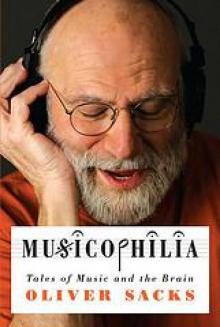 Musicophilia
Musicophilia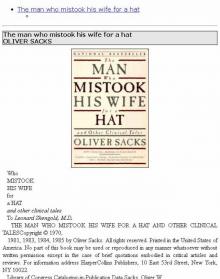 The man who mistook his wife for a hat
The man who mistook his wife for a hat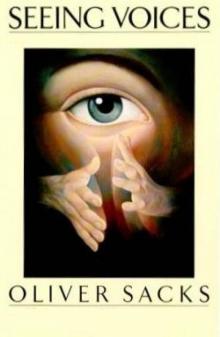 1989 - Seeing Voices
1989 - Seeing Voices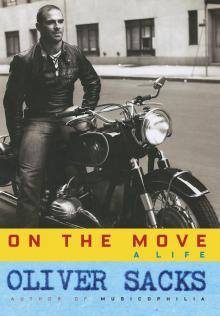 On the Move: A Life
On the Move: A Life 1996 - The Island of the Colorblind
1996 - The Island of the Colorblind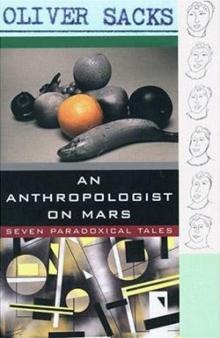 An Anthropologist on Mars: Seven Paradoxical Tales
An Anthropologist on Mars: Seven Paradoxical Tales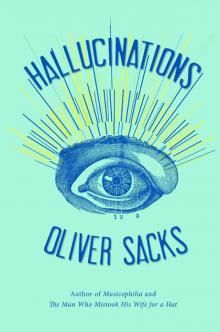 Hallucinations
Hallucinations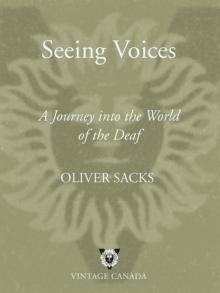 Seeing Voices
Seeing Voices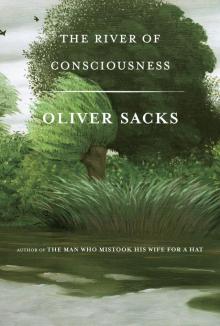 The River of Consciousness
The River of Consciousness Vintage Sacks
Vintage Sacks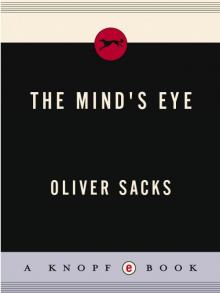 The Mind's Eye
The Mind's Eye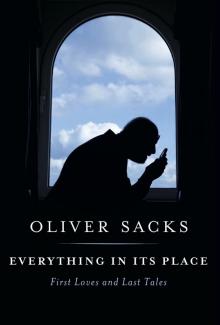 Everything in Its Place
Everything in Its Place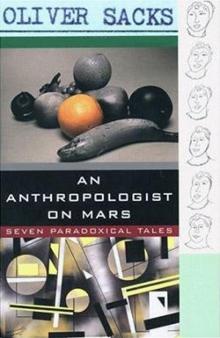 An Anthropologist on Mars (1995)
An Anthropologist on Mars (1995) Uncle Tungsten: Memories of a Chemical Boyhood (2001)
Uncle Tungsten: Memories of a Chemical Boyhood (2001)